
A basic and light guide with tips and tricks I’ve picked up during the four years of playing The Long Dark as your average player. No hardcore elements, just plain knowledge of how to make your surviving experience a bit nicer (and hopefully a bit longer, too).
Basic Mindsets
If you’re coming from most other open world games, you’ll probably have learned that parts, crafteables and items respawn, enemies’ powers are below yours, food is more of a burden than a necessity, health can be fixed in seconds, death is only temporary, etc etc. Well, forget all that (Except if you play The Oregon Trail, then remember some of it, like the risk of dysentery) and follow these mindsets when throwing yourself into the world that is The Long Dark:
- Waste not, want not. Everything you find can be used to ease your survival.
- Hostile wildlife is not to be trifled with. You are not on top of the food chain anymore.
- Planning, being observant and careful is 75% of your success. The rest is luck.
- Oh, and “sparingly” is a good overall theme to keep in mind.
- Precise and efficient looting is key to precise and effective survival. Check every surface, every
nook and cranny. On top, underneath, besides, and so on, and do it WITH a light. - You will probably die by stupid, minute mistakes multiple times before you get the hang of it.
- You will probably die by stupid, minute mistakes even when you’ve gotten the hang of it.
Exploration & Expeditions
Plan your trips outside! Never ever wander outside without checking and double checking that you have everything you might need on your person. Even the shortest of trips can become a death trap if you’re unprepared.
If you plan on surviving an extended amount of time, you’ll probably want to travel between regions. Establish a safe house (or at least a snow shelter, though these can quickly become ruined and rendered unusable and thus a complete waste of energy and supplies) in each region to stash unnecessary items you find along the way to lighten your load.
Use sprinting sparingly. It drains your calories and your fatigue. Stamina regenerates slowly. If you’re not in a dire situation, save the sprinting until you’re sure you’re out of harms way.
Climbing up ropes is extremely tiring. Be prepared to deal with tiredness or possibly exhaustion immediately or soon afterwards. Climbing down is not nearly as tiring.
You cannot climb up or down ropes if over-encumbered.
For one whole day of exploring the great outdoors, I always bring:
- Knife and hatchet.
- 8+ matches (and/or fire striker + magnifying glass).
- Tinder (unless level 3 fire starting or higher).
- Bed roll (trust me, it WILL save your life).
- 2 flares.
- 4 tablets of painkillers and antibiotics, a bottle of antiseptic (always bring the same bottle as it’s weight decreases by use) OR 2 cups of reishi tea and rose bud hip tea, 2 old man’s beard lichen wound dressings + 2 bandages and 1 instant stim.
- At least 1,50 l of water (preferably more) and 1500+ calories of food (also preferably more).
- A weapon. If you have both a rifle and bow, bring both (with no more than 5 bullets and 7 arrows).
- 2-7+ charcoal (2 if you’re prone to get lost, more than that if you’re planning to explore unmarked areas).
Refrain from carrying around a fully loaded gun or too many arrows (unless hunting moose; then you’ll need to bring extra). You’ll be more prone to waste bullets/arrows if you think you have “more than enough” and the little trigger happy FPS gamer in you might begin thinking up a fun idea to try to hit some crows just for the heck of it. Treat your bullets like they are made out of gold!
Even though sprinting should be used sparingly, it is vital that you are still able to do so if you need to. Try to not wear clothes that bring your sprinting capacity under 70%.
When using charcoal to draw your map, it will automatically place you on the correct position on the map you’re currently in. This way you can get a hint of whether you’re close to the centre, edge or a corner, and by going in any one direction for a while and then drawing it again will also give you a hint of how big the location is.
Drawing on your map can help a lot if you’re lost. Even if it’s already filled in, it will centre around the area you’re currently in.
You will only be able to draw what you see; you can’t magically see through hills or houses.
Walking on paved roads are faster than walking on snow or ice.
You can safely pack up to 15 kg more than your limit without getting too slow, though it will make sprinting ridiculously slow.
Having more than 15 kg over your limit in your inventory will make sprinting impossible.
Food & Water
Food under 35% condition is (in my experience) too risky to eat. Be prepared to medicate potential food poisoning if you take that risk. The food will still be sating and as calorie rich despite the poisoning.
The condition of uncooked meat and fish improves by 50% when cooked, regardless of how bad it was before. This also includes ruined meats, which means cooking them will restore them to edibility.
Leaving meat (both uncooked and cooked) outside in the snow greatly increases the time it takes for them to spoil. Keep them just outside a door for easy access even in bad weather. (does not work with any other type of food items, such as cans, bars, sodas, etc.)
When reaching cooking skill level 5, nothing will give you food poisoning. Ever. You can leave meat to completely spoil and show as “ruined”, but you can still eat it and nothing bad will happen.
Consumables marked as “ruined” will not show up in the quick-choice “wheel” (???) under food, but they are still consumable through the food section of your inventory.
Un-brewed herbal tea and coffee spoils; brewed cups do not. The condition of the drinks do not have a 50% increase when cooked.
Cat tail stalks, Reishi mushrooms and rose hip buds do not spoil. Like brewed herbal tea or coffee, cooked medicinal tea does not spoil either.
If you don’t have a can opener in your inventory and you open canned foods, you will use your knife (or hatchet?) and with that, it’s condition will drop.
Wildlife & Hunting
Fishing is a great and effective way to get food and lamp oil, though the meat is heavy and spoils quickly.
Placing a campfire next to a carcass before harvesting thaws it while also keeping nosy wildlife away.
The more meat, fish, fresh guts and fresh hides you carry with you the more interested the wildlife will become. Raw and fresh stuff is the most fragrant while cooked meat is slightly less so. While only carrying some, wildlife will sense you from farther away. While carrying increased amounts, they will try to find you. While carrying a whole lot, they will actively hunt you down.
When using either a knife or hatchet (or hammer?) while fighting a wolf, it will damage the wolf and probably make it begin to bleed out sooner or later. Following the fresh trail of blood and engage in another confrontation is unnecessary and wasteful of your own tools, condition and potentially to your clothing. Heal and seek shelter and try to locate the wolf the next day instead.
Animal carcasses stay where they are for about 2 days before disappearing. Harvest what you need before that.
A hit with a bullet and/or arrow that draws blood might cause the animal to flee, leaving a trace of blood behind them. If you’re lucky, it might die soon after of bloodloss. This way you can hunt and bring down large animals using only minimal amounts of ammunition, though you’ll have to track the carcass down once it’s dead and it can be hard to find in certain terrain.
If you’ve shot at and hit an animal and want to know if it has died or not, keep track of your Stats. It will show how many animals you’ve brought down and will automatically increase if an animal you’ve hit bleeds out.
Bears leave you barely alive if they attack you when you’re at full condition; if they attack and you’re under 95%, you’ll most likely die. They are quick and if one comes charging at you can’t outrun it. If you decide to confront one, BE SURE YOU CAN GET AWAY ALIVE. Approx. 3-5 rifle shots (depending on where you hit and your rifle skill) will kill a bear, unless you get a head shot.
Moose are “nicer” on your health but will cause broken ribs if they decide to come charging. However, they are tougher to take down than bears and take approx. 5-7 rifle shots (also depending on where you hit and your rifle skill) to kill, unless you get a head shot, though you might require two head shots if you’re at low rifle skill.
Rabbits go down with one arrow hit, wolfs with 1-2, deer with 1-3, bears with 3-10. The only moose I have yet to kill with bow and arrow (three of them) went down with 5-10 arrows, but that number might be off as it’s for such a small amount of tries.
Having a lit flare thrown at a wolf is NOT guaranteed to scare if off.
Neither is brandishing a torch.
Or throwing rocks.
There is a small chance of wolfs getting scared and fleeing when they see you; that chance increases if you are wearing clothes made out of wolf or bear hides and/or are carrying a bear bed roll, but keep in mind that this chance is still miniscule even when dressed in bear coats and carrying bear skin bed rolls.
You can loose stalking wolves (aka. wolves that are following you, growling) by walking out of sight or indoors. Some wolves will tire and stop stalking you when they’ve followed you for some time, while others will eventually attack.
If the distance between you and a stalking wolf is too great, it will come running towards you to gain up on you again, however, this is almost never a charge to attack.
Do not run from a stalking wolf! This will trigger them to instantly charge to attack you.
Wolves will hunt down pray now and again. This is a perfect way to harvest meat, hides and guts without doing any work. Wolves will often leave between 0.5 and 3 kilos of meat on a deer, along with the guts and hide.
When a wolf is snacking on their pray, they will not go after you if they spot you, but will instead protect the carcass and only attack if you come too close. One way to maximize the outcome of resources is to shoot the wolf and harvest both of the carcasses with only half the work, though this can backfire and result in you getting attacked and/or wasting a shot/arrow only scaring the wolf away.
Wolves and bears are attracted by the scent of carcasses. If you camp by one and don’t have a lit campfire keeping them away, watch your back for uninvited dinner guests.
Stones are free. Stunning rabbits with stones are free. Snapping the rabbits’ necks are free. Is it easy? Nope. Is it worth it? If you get good at it, yes.
Tools & Maintenance
Building and maintaining a snow shelter just outside your house is an easy way to deal with and prevent cabin fever as spending time in it and sleeping in it won’t count as time spent indoors.
If you spend a lot of time indoors doing crafting and risk getting cabin fever, consider saving some of the tasks that doesn’t require a workbench and do them while inside your trusty snow shelter.
Try not to mend clothes as soon as they start to deteriorate. Sewing kits, although common, are limited. Keep your most vital clothing items, such as your coat(s), pants and shoes, at 70% or higher, the rest at 50% or higher.
Clothes and tools at 0% condition (“ruined”) cannot be mended/improved/sharpened.
Knifes and hatches are vital to your survival, but they do not last forever. Whenever you can afford to, try to use your hands or another tool that is not needed for much, like the crowbar.
The crowbar is pretty much useless for anything but opening locked car trunks and a couple of lockers. Use them for other things like breaking ice holes to spare some condition of your knife and hatchet.
Arrowheads never wear out. Arrow shafts however, do, so don’t use arrows carelessly.
The aurora counts as a light. Use it to read books and craft things in the middle of the night.
Fire & Camping
Do not waste time gathering massive amounts of tinder as tinder becomes useless after reaching fire starting level 3. By then you can start fires without any tinder and even if you decide to use tinder, it does nothing.
Do not waste a lit campfire. Melt and boil water, cook meat and/or take torches until it burns out.
You can use lit torches to light another torch (if the first one is thrown to the ground while still on fire) or a camp fire/stove/fire barrel. Don’t waste matches or other fire starters.
Fire starting items (matches, firestrikers, etc.) are degradable and will eventually run out; make sure that is later rather than sooner.
Using a storm latern only requires lamp oil and no fire starting items, though it cannot be used to help light a fire.
A tedious but effective way to save on matches, flares and increase your safety from wildlife attacks while travelling long distances is to bring a good amount of torches (like ones with bad condition that you may have picked from a fire you no longer needed). Light the first one and when that is almost out, throw it on the ground, equip a new one and click on the old one. This will light your new torch. Keep doing this to save matches. Though beware that torches are relatively heavy and this method requires quite a lot of them.
Locations & Regions
In my opinion, these are the Easiest to Hardest regions, in that order:
- Mystery Lake: Not a lot of wildlife. Has fishing huts. Easy to navigate without encountering too many hostile wolves, bears or moose. Has some of the best indoor locations in the entire game: Office Lake House and Hydro Carter Dam.
- Coastal Highway: Very populated with hostile wildlife that literally comes right up to your doorstep, including two very curious bears, but is littered with houses, trailers and other locations suitable for a safe house scattered all over. Loot galore! Very convenient location on the world map with connections to DP (Desolation Point) and ML (Mystery Lake). And, of course, fishing huts.
- Mountain Town: A lot of houses, including Grey Mother’s house which make for an excellent safe spot, though not that much loot. Sparse wildlife which, in this case, makes it tougher for a long time camp out. Overall indoors location layout besides town “centre” is scattered and can be hard to navigate if stuck in a blizzard.
- Desolation Point: Large open areas and not too packed with wildlife, and has one of the only two furnaces. The Lighthouse make for a perfect safe house while also providing a good lookout. Not that many indoors locations, but a great deal of resources and crafting opportunities. Coal in loads.
- Forlorn Muskeg: Two words: Thin ice. Everywhere. The entire centre of the map is thin ice with a few sturdy spots of safe ground. Thread carefully or you’ll go through the ice. Just kidding, you’ll go through anyway. Large areas are untraversable, but the hostile wildlife is sparse, there’s free sight to hunt bears from several hunters huts, mushrooms and other plants are plentiful, and the second one of the only two forges required to make improvised tools and arrowheads is located there.
- Pleasant Valley: It might seem stupid to put FM before PV, but hear me out. Pleasant Valley is sparse in just about everything: indoors locations, lootables, clear weather. There’s a real risk of trying to go out to, well, anywhere, because you run the risk of getting lost and trapped in a blizzard. Chances are you’ll be forced outside to wander around looking for anything useful while getting dangerously cold and hungry, because useful indoors loot is not common and locations to find some are few and far between.
- Timberwolf Mountain: Do I really need to explain this? You’re on a mountain. There’s snow. There’s rock. One mushroom if you’re lucky, but you’ll probably have no time to eat it before you freeze to death in a blizzard. Try not to fall off the ledge.





Depends on food. My guidelines: soda is always safe, various bars and jerky are good unless they’re mouldy, canned goods over 50% are safe, meat over 80%, and sardines over 95%. Seriously, sardines are a trap. Not sure how accurate that is, but I haven’t had food poisoning for more than a year in game.